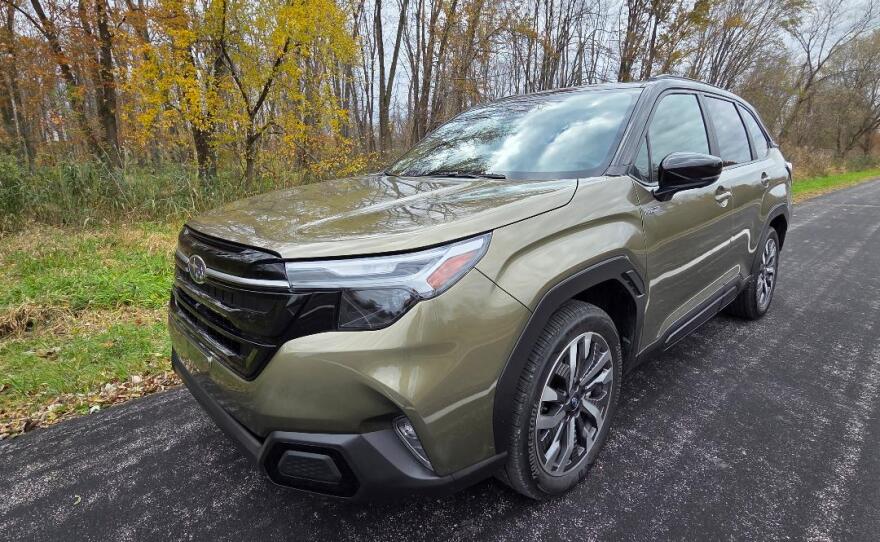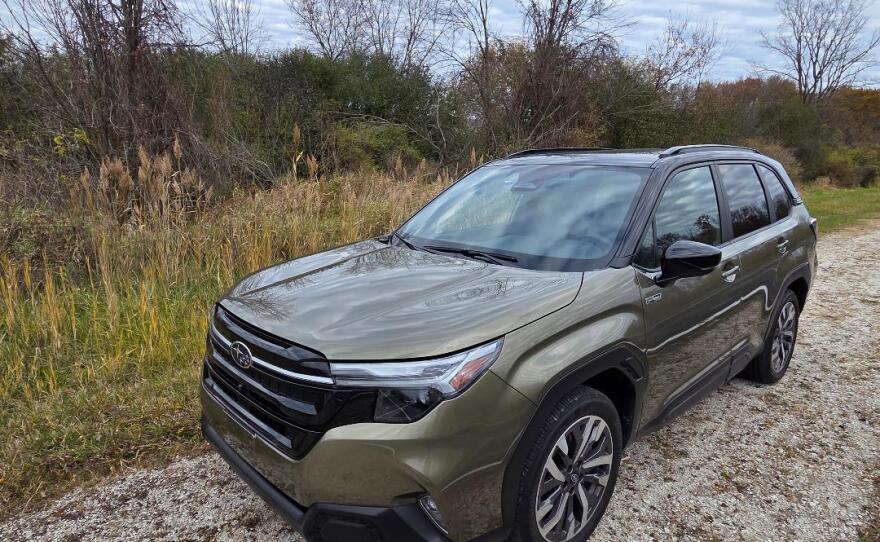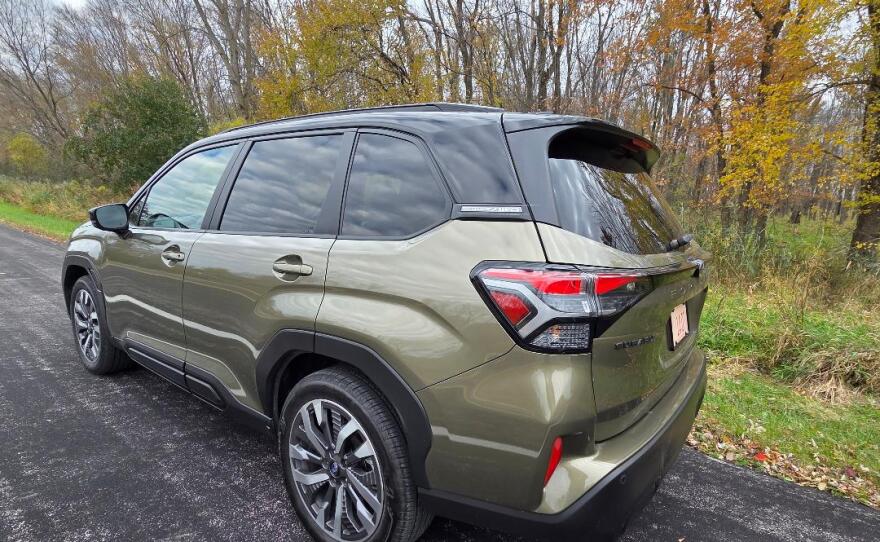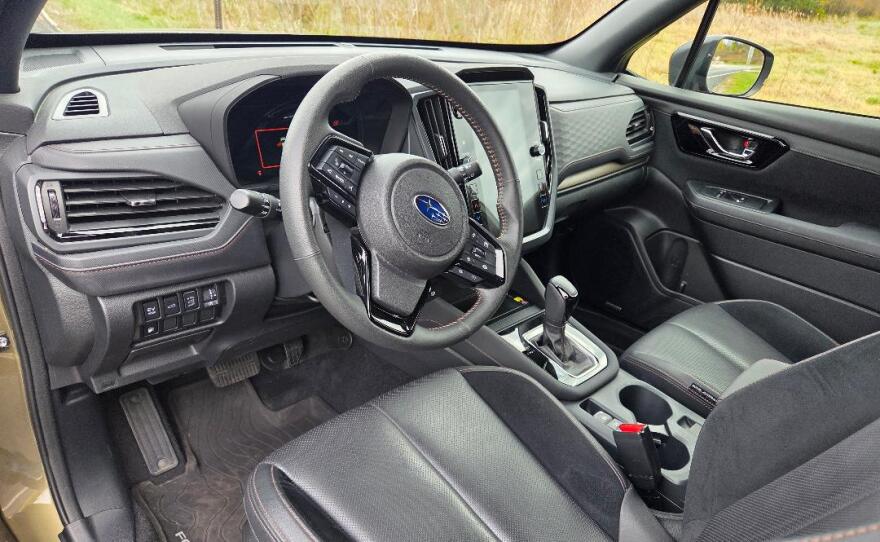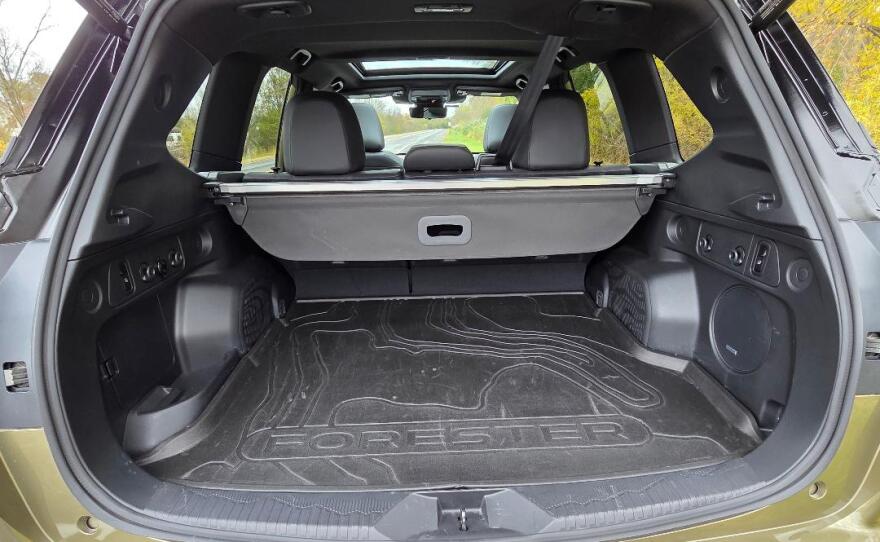I don’t want to belabor the point, but Subaru should have come to the hybrid market sooner than 2025. It was a natural fit with Subaru’s woodsy environmentally friendly ethos. But better late than never. This year, the Japanese car maker finally introduced a hybrid in its popular Forester compact SUV. Full disclosure, I previously owned a Forester, and our family owns a 9-year-old Subaru Outback.
The hybrid Forester is a huge step forward for Subaru as it has borrowed a Toyota hybrid system to link to an efficient Atkinson-cycle version of its 2.5-liter Boxer four. But Subaru has re-engineered the hybrid to meet its standards so that the hybrid system powers all four wheels via Subaru’s symmetrical AWD system. Most hybrids only power the front wheels and use electric motors to achieve AWD.
The difference? Well, the power is much smoother and the AWD control is much more even and predictable with Subaru’s system. Aiding that, the Forester Hybrid now uses a planetary gear in its CVT instead of pulleys and a chain belt to smooth transmission operation. The downside, Subaru gives up some gas mileage savings with its smoother system. For instance, Forester’s combined mpg is 35 while a Toyota RAV4 is rated at 39 mpg. I managed 33.3 mpg compared with 28 mpg in an earlier gas model.
Still, with the hybrid system, the Forester is estimated to save an average driver at least $25 a month in fuel costs, which translates into about a 5- to 6-year payback as the hybrid on average costs $1,700 to $2,000 more than a gas-only version.
But there are other advantages beyond gas savings, which translates to less exhaust pollution over the life of the vehicle.First, the Forester hybrid boasts 14 more horsepower at 194 vs. 180 in the gas-only model. Torque also is greater and power delivery smoother too. Zipping onto a freeway, the Forester feels more confident as the Subaru is well balanced and its full-time AWD assures that even if one hits a puddle or slick pavement there will be good traction.The hybrid models also are quieter, meaning less engine noise to distract a driver, or muddle conversations. Subaru has added more sound deadening material to all Foresters, plus the windows here are thicker to help muffle road noise. Off-roading remains possible, too, as the Forester hybrid features 8.7 inches of ground clearance, best in class for today’s compact SUVs.
There’s also a 360-degree surround-view monitor, heated and cooled front seats and heated rear seats in the tested Touring Hybrid. Need more? Subaru also adds a new 12.3-inch digital gauge cluster for the driver, a unique feature to hybrid models. The Touring trim also has 10-way power driver’s seat with two-memory settings and a power lumbar support.
Seats are black leather-trimmed and feature bronze stitching as does the dash and leather-wrapped steering wheel. There’s gloss black trim by the chrome door release handles and the same around the console-mounted gear shift. Otherwise, the console is a matte finish. There’s also velour trim on the seats and door inserts, adding to the quiet quality of the interior and its higher-end looks. So, Subaru is making the hybrid more than just another powerplant choice, it’s moving hybrid models up the food chain a bit in amenities and appearance too. The test vehicle was a two-tone Autumn Green Metallic with black roof, just $495 extra, but a standout appearance package for the small SUV.
Like all Foresters, the handling is light and nimble making it easy to park and control on the highway. I had this on a couple fall days with gusty high winds and while you could feel the winds, Forester felt well planted in its lane (the hybrid weighs about 280 lbs. more than the gas model), even when the big rigs flew past at 80 mph. I guess they were empty!
Ride has been much improved over previous Forester models, smoothed considerably and with the extra sound deadening this becomes a fine family highway hauler for vacations and trips up North.
Forester’s interior is roomy too, easy to fit four adults and five if need be with good rear seat leg and headroom. Cargo space isn’t hurt by the hybrid system either, the Forester hybrid touting 28 cubic feet of space behind the rear seat and 69.1 cubic feet if the split rear seat if folded down. This one also has a hands-free power hatch and rubber mat in back to hold cargo in place. Seating is supportive and comfortable, better than some small utes I’ve tested of late. The three-level heating and cooling helps in summer and winter and the heated steering wheel takes the chill off now that Wisconsin is settling into winter.
I like the dash layout, but the big center info screen remains a bit tough to deal with when driving. Oh, it’s big enough, but reflects a lot on sunny days and is so busy as to be distracting to tune while driving. A plus, there’s an included navigation system and wireless Apple CarPlay and Android Auto. Further benefits, an easy wireless charger below the screen at the console’s front edge, a nice stereo system, and bigger than expected sunroof overhead with manual sunshade. Subaru also includes its fine EyeSight safety system with its driver assist features and DriverFocus to make sure a driver is paying attention and looking forward. This system did not seem to be put off by a driver wearing sunglasses. Some touchy systems on other makes beep repeatedly. Ugh!
Pricing? Well, a Premium trim Forester Hybrid, the lowest level, starts at $38,015. That might seem high compared with a base gas-only model that lists at $31,445, but the Premium model is better equipped. There are also Sport and Limited hybrid trims.
But let’s compare apples to apples. The gas top-end Touring model lists at $43,045 while the tested Touring Hybrid was just a smidge more at $43,115 with delivery. Add in the snazzy paint job and the tester ended at $43,610 in a market where the average new vehicle runs $50,000.
Need another reason to consider a Forester Hybrid? t earns a 5-star safety rating from the National Highway Traffic Safety Administration, and includes a 5-year, 60,000-mile powertrain warranty. Finally, Subaru has a competitive hybrid, and word is that the system is soon coming to its top-selling CrossTrek.
FAST STATS: 2025 Subaru Forester Touring Hybrid
Hits: Light, nimble handling, smooth power, AWD, improved ride and quiet interior. Supportive heated front seats, power driver’s seat, big info screen, wireless charger, nice stereo, big sunroof, EyeSight safety system standard. Large cargo area, modest pricing for hybrid, plus good mpg.
Misses: Big screen too busy for easy use while driving.
Made in: Japan
Engine: 2.5-liter Boxer 4/Atkinson cycle, hybrid, 194 hp/199 torque
Transmission: Lineartronic CVT automatic
Weight: 3,946 lbs.
Length: 183.3 in.
Wheelbase: 105.1 in.
Ground clearance: 8.7 in.
Cargo: 28/69.1 cu.ft.
Tow: 1,500 lbs.
MPG: 35/34
MPG: 33.3 (tested)
Base Price: $43,115 (includes delivery)
Invoice: $40,272
Major Options:
Autumn green metallic two-tone paint, $495
Test vehicle: $43,610
Sources: Subaru, www.kbb.com




